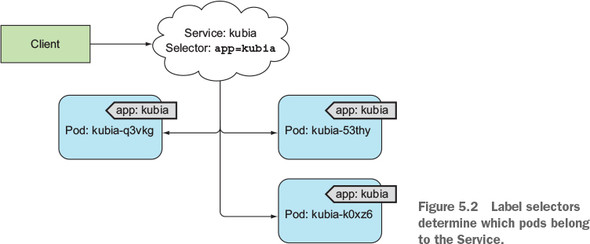Services
svc. (You can type service or services or svc in your command.)Pods can be moved accross nodes (thus assigned a different IP), or even replicated (the set of pods' IPs at one time may be different to another).
A service solves this issue by exposing multiple pods at a single constant IP-and-port pair (Lukša). Instead of connecting to the pods directly, you should connect to the service using its static IP.


Service descriptor
Mention selector (pod label selector, i.e., which pods handle the service) AND ports (ports mapping):
apiVersion: v1
kind: Service
metadata:
name: kubia
spec:
# ClusterIP is the default type of services,
# so you don't have to specify it:
# type: ClusterIP
selector:
app: kubia
ports:
- port: 80
targetPort: 8080
Without selectors
You can create a Service descriptor without the selector field, but you will need to manage your own Endpoints.
Using named ports
You can target named ports in your pod's descriptor.
If those port number changes, you don't need to change the references to those ports which use the ports' name.
apiVersion: v1
kind: Pod
spec:
containers:
- name: kubia
ports:
# here's a pod named http in the container
- name: http
containerPort: 8080
# here's a pod named https in the container
- name: https
containerPort: 8443
apiVersion: v1
kind: Service
spec:
ports:
# target the pods' "http" port
- name: service-http-port
port: 80
targetPort: http
# target the pods' "https" port
- name: service-https-port
port: 443
targetPort: https
Discovering services
For pods to connect to a service, you don't always need to create the service first and then manually look up its IP and port.
Kubernetes provides some methods for service discovery.
Through environment variables
When a pod is started, all preexisting services' ports and IPs are exposed through environment variables.
The services' names will be converted to SNAKE_CASE. If your service's name is xxx, you will see these environment variables:
XXX_SERVICE_HOST— telling you the service's hostXXX_SERVICE_PORT— telling you the service's port
kubectl exec kubia-3inly env
# PATH=/usr/local/sbin:/usr/local/bin:/usr/sbin:/usr/bin:/sbin:/bin
# HOSTNAME=kubia-3inly
# KUBERNETES_SERVICE_HOST=10.111.240.1
# KUBERNETES_SERVICE_PORT=443
# ...
# KUBIA_SERVICE_HOST=10.111.249.153
# KUBIA_SERVICE_PORT=80
# ...
Through DNS (only for the IP)
When you list pods in the kube-system namespace, you will see a Kubernetes DNS pod, named either:
kube-dns-<something>for Kube-DNS, orcoredns-<something>for Core DNS.
You can perform a DNS query (in the form of fully qualified domain name, aka FQDN) to get a service's IP address (you still need to know the port yourself).
Example
Using DNS resolution allows you to do stuff like this (note that you don't need to know the IP of the kubia service in the pod's SSH session):
kubectl exec -it kubia-3inly -- bash
# root@kubia-3inly:/# curl http://kubia.default.svc.cluster.local
# You've hit kubia-5asi2
Service FQDN format
A sample FQDN is as follows (you can configure the .cluster.local suffix if you want):
# <serviceName>.<serviceNamespaceName>.svc.cluster.local
backend-database.default.svc.cluster.local
Configuring DNS lookup behavior
Kubernetes sets the default DNS lookup behavior in each container by writing a /etc/resolv.conf file (e.g., it sets the IP of the DNS server).
You can modify this behavior by changing the resolv.conf file yourself. For example, setting the search field will allow you to automatically expand queries like data to data.test.svc.cluster.local:
# /etc/resolv.conf
# 'data' queries can be expanded to 'data.test.svc.cluster.local', etc.
# see https://www.man7.org/linux/man-pages/man5/resolv.conf.5.html
nameserver 10.32.0.10
search test.svc.cluster.local svc.cluster.local cluster.local
options ndots:5
Excluding pods for DNS query
Set the dnsPolicy field in each pod's spec.
Working with services
Creating a Service
You can use a descriptor file:
kubectl create -f <filename>
Or the kubectl expose command:
kubectl expose pod <podName> --type=LoadBalancer --name <serviceName>
Listing Services
kubectl get svc
# NAME CLUSTER-IP EXTERNAL-IP PORT(S) AGE
# kubernetes 10.111.240.1 <none> 443/TCP 30d
# kubia 10.111.249.153 <none> 80/TCP 6m
Describing a Service
kubectl describe svc <serviceName>
References
- Kubernetes in Action (Marko Lukša) — Chapter 2. First steps with Docker and Kubernetes
- Kubernetes in Action (Marko Lukša) — Chapter 5. Services: enabling clients to discover and talk to pods
- Service — https://kubernetes.io/docs/concepts/services-networking/service/
- DNS for Services and Pods — https://kubernetes.io/docs/concepts/services-networking/dns-pod-service/
- Kubernetes DNS for Services and Pods — https://medium.com/kubernetes-tutorials/kubernetes-dns-for-services-and-pods-664804211501